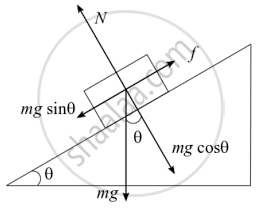Advertisements
Advertisements
Question
A block of mass 1 kg is pushed up a surface inclined to horizontal at an angle of 30° by a force of 10 N parallel to the inclined surface (Figure). The coefficient of friction between block and the incline is 0.1. If the block is pushed up by 10 m along the incline, calulate

- work done against gravity
- work done against force of friction
- increase in potential energy
- increase in kinetic energy
- work done by applied force.
Solution
Consider the adjacent diagram the block is pushed up by applying a force F.

Normal reaction (N) and frictional force (f) is shown.
Given, mass = m = 1 kg, θ = 30°
F = 10 N, μ = 0.1 and s = distance moved by the block along the inclined plane = 10 m
a. Work done against gravity = Increase in PE of the block
= mg × Vertical distance travelled
= mg × s(sin θ) = (mgs) sin θ
= 1 × 10 × 10 × sin 30° = 50 j ....(∵ g ≤ 10 m/s2)
b. Work done against friction
wf = f × s = μN × s = μ mg cos θ × s
= 0.1 × 1 × 10 × cos 30° × 10
= 10 × 0.866
= 8.66 J
c. Increase in PE = mgh = mg (s sin θ)
= 1 × 10 × 10 × sin 30°
= `100 xx 1/2`
= 50 J
d. By the work-energy theorem, we know that work done by all the forces = change in KE
(W) = ΔK
ΔK = Wg + Wf + Wf
⇒ = – mgh – fs + FS
= – 50 – 8.66 + 10 × 10
= – 50 – 8.66
= 41.34 J
e. Work done by the applied force, F = FS
= (10)(10)
= 100 J
APPEARS IN
RELATED QUESTIONS
A body of mass m is placed on a table. The earth is pulling the body with a force mg. Taking this force to be the action what is the reaction?
A boy is sitting on a chair placed on the floor of a room. Write as many action-reaction pairs of forces as you can.
When you hold a pen and write on your notebook, what kind of force is exerted by you on the pen? By the pen on the notebook? By you on the notebook?
Let E, G and N represent the magnitudes of electromagnetic gravitational and nuclear forces between two electrons at a given separation. Then
A proton exerts a force on a proton which is
(a) gravitational
(b) electromagnetic
(c) nuclear
(d) weak
Mark the correct statements :
(a) The nuclear force between two protons is always greater than the electromagnetic force between them.
(b) The electromagnetic force between two protons is always greater than the gravitational force between them.
(c) The gravitational force between two protons may be greater than the nuclear force between them.
(d) Electromagnetic force between two protons may be greater than the nuclear force acting between them.
A monkey is sitting on a tree limb. The limb exerts a normal force of 48 N and a frictional force of 20 N. Find the magnitude of the total force exerted by the limb on the monkey.
A man moves on a straight horizontal road with a block of mass 2 kg in his hand. If he covers a distance of 40 m with an acceleration of 0⋅5 m/s2, find the work done by the man on the block during the motion.
A box weighing 2000 N is to be slowly slid through 20 m on a straight track with friction coefficient 0⋅2 with the box. (a) Find the work done by the person pulling the box with a chain at an angle θ with the horizontal. (b) Find the work when the person has chosen a value of θ, which ensures him the minimum magnitude of the force.
A body is moving unidirectionally under the influence of a source of constant power supplying energy. Which of the diagrams shown in figure correctly shows the displacement-time curve for its motion?
